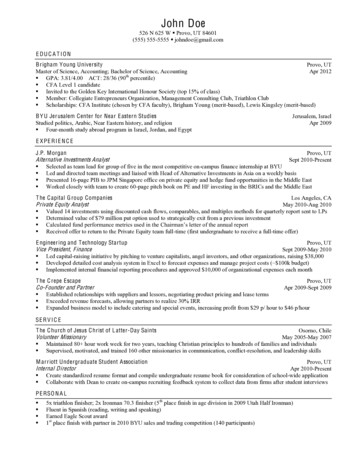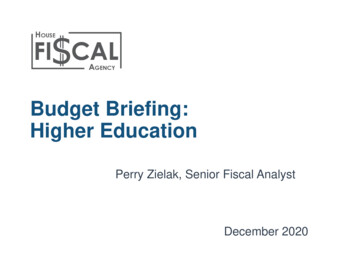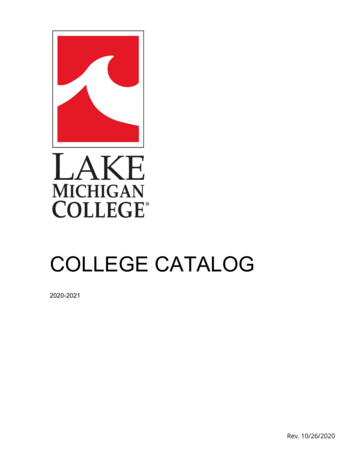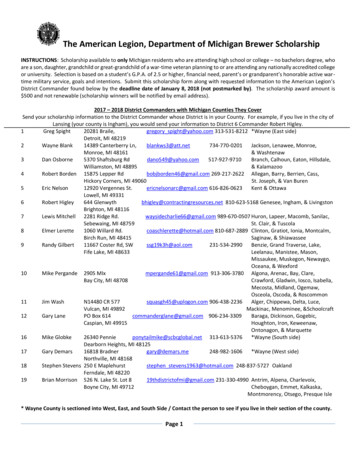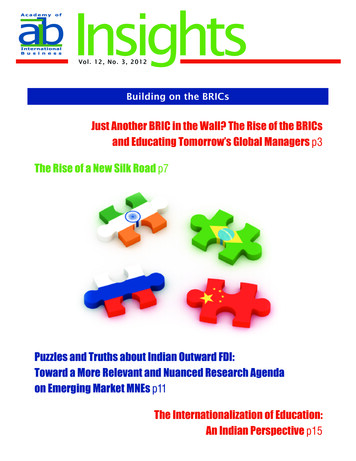
Transcription
InsightsVol. 12, No. 3, 2012Building on the BRICsJust Another BRIC in the Wall? The Rise of the BRICsand Educating Tomorrow’s Global Managers p3The Rise of a New Silk Road p7Puzzles and Truths about Indian Outward FDI:Toward a More Relevant and Nuanced Research Agendaon Emerging Market MNEs p11The Internationalization of Education:An Indian Perspective p15
Building on the BRICsE verG oldman S achs“Dreaming with the BRICs”1 report in 2003, theBRIC (Brazil, Russia, India and China) countries have become an attraction for researchers,investors, and practitioners of international business. The report suggested that BRICs willeconomically overtake the G7 countries, and China, in particular, will overtake the US asthe largest economy in the world. The whitepaper concluded that by 2025, the BRICs willaccount for over half the size of the G6.since theWhile the economic growth rates of these countries remain high, in comparison to thedeveloped world, improvements in governance have lagged. According to the World Bank’sgovernance indicators, political risk, rule of law, control of corruption, voice and accountability,regulatory quality, and government effectiveness remain dismal. The lack of significantprogress in governance raises important questions for IB educators and researchers. Whatwill the future of the BRICs be? What should we teach our students about BRICs? Is the BRICgrowth model sustainable? Can the BRICs be usefully analyzed monolithically? While thesequestions will remain contested for some time, this issue provides some thought-provokinginsight into practices in the BRIC nations and, in particular, in China and India.Ilan Alon, EditorRollins Collegeialon@rollins.eduIn the first article, Asta Salmi and Joanna Scott-Kennel suggest that the rise of BRIC requires achange in mindset by international business educators: theories of competitiveness, growth, multinational companies, andconsumers need to be re-examined in light of the changes in the global arena. While in the past, knowledge and capitalflows started in the West, the new global reality is one of multi-polarity, where the periphery is becoming more central. Theauthors discuss how that may affect IB scholars’ creation and diffusion of new knowledge, including research and teachingabout BRICs.In the second article, Ben Simpfendorfer attempts to change the global mindset of readers by highlighting the relationshipbetween China and the Middle East, particularly the Arab world. The Arab world is increasingly inspired by China, and thecenter of influence is slowly moving from the West-dominated Washington consensus to the more culturally-relevant Beijingconsensus over governance and economic development. Simpfendorfer shows the historical connections between theArab world and China and its new manifestations in the modern world. As trade continues to grow beyond only oil, and aslinguistic and cultural connections solidify, China’s influence in the Middle East will eventually dwarf that of the West.In the third article, Victor Zitian Chen discusses the “Puzzles and Truths about Indian Outward FDI.” Why do poor countriesinvest abroad? On the surface, it seems contradictory to the investment development path (IDP) developed in the 1970s and1980s. However, if the large domestic market of BRIC is divided into sub-national markets, different institutional environmentsand levels of development may account for such outward investment. More specific to the Indian market, Chen explains whyIndian firms invested earlier than their BRIC counterparts in R&D and skill-related businesses and in developed markets. Amulti-theoretic approach and a more nuanced analysis at the sub-national and city levels may explain the differences amongBRIC emerging market multinationals’ investments abroad.The final article in this issue, P.J. Lavakare discusses the internationalization of higher education in India. Lavakare rejectsthe notion that education is simply a “business” and suggests that universities viewing India as only a place to recruit forrevenues will face opposition, both political and social. Internationalization of higher education is looked at in India as ameans of improving the quality of higher education in India and a process for enhancing national research capabilitiesthrough international collaboration of mutual interest. India struggles to define “internationalization” for its universities andis slow to implement effective policies. Unlike private businesses, described in the article by Chen, Indian universities andregulatory bodies need a more global perspective but lack the funding, institutional support, and ability to implement worldstandards in higher education internationalization.12See: ics/brics-dream.htmlAIB InsightsVol. 12, No. 3
Just Another BRIC in the Wall? The Rise of the BRICsand Educating Tomorrow’s Global ManagersAsta Salmi, Aalto University, FinlandJoanna Scott-Kennel, University of Waikato, New ZealandT he BRICcountries (Brazil, Russia, India, and China) comprise40 percent of the world’s population (approximately 2.8 billion people),cover more than a quarter of the world’s land area over three continents,and account for more than 25 percent of global GDP (by purchasingpower parity). In the ten years since the term BRICs was first coined byJim O‘Neill, chief economist of the investment bank Goldman Sachs, alleconomies (except Brazil) have exceeded their predicted growth rates(Müller, 2011). Integration into the global economy coupled with risingspending power prompts flows of students (and expatriates) to, andfrom, the BRICs—positioning international business educators at thehelm of this sea-change. In this article, we reflect on the implicationsof the rise of the BRICs for educating the next generation of businessmanagers and leaders. We argue that rather than just another “brick inthe wall,” educating tomorrow’s managers requires adoption of a globalmindset by international business educators. This enables them to buildon, or indeed begin to dismantle, existing theoretical and pedagogicalfoundations, brick by brick.Global Mindset in a Multi-polar WorldIn the multi-polar world, the BRIC economies (closely followed by Indonesia) will be major contributors to global growth, key players infinancial markets (three quarters of official foreign exchange reservesare already held in emerging markets), and active participants in international institutions (World Bank, 2011). Integration of the BRICs intointernational economic groupings and institutions through trade, investment, and political engagement will increasingly shape the macroenvironment of international business. Such changes herald new rulesof the game (e.g., business practices, inter-company and -country alliances), new players (e.g., BRIC managers, MNEs, NGOs, and governments), and rising competition for global resources and markets.Multi-polarity will also influence the institutional, cultural, andtechnological landscape of international business. Today, the onusfor learning falls on firms from BRIC countries as they seek access todeveloped markets by integrating into the existing institutional andcultural foundations of Western-style business. As the influence ofthe BRICs grows, however, today’s approach of accommodationand assimilation into the Western-oriented system of business willshift further toward integration and inclusion of business practiceapproaches from emerging markets. Indeed, in countries wherebusiness infrastructure is less well established and investment by BRICVol. 12, No. 3MNEs is high (such as Chinese investment in extractive industriesin parts of Africa and Latin America; Gugler & Fetscherin, 2010), suchbusiness practices may become the norm — and may even providean advantage. BRIC companies, having developed in emerging marketsfor labor, products, and capital, are often adept at operating in suchinstitutional voids.In business, as well as education, cultural influence has been unidirectional from the US center to the UK and European semi-periphery,and then to the peripheries (i.e., the rest of the world). With the rise ofthe BRIC economies we expect the span and direction of such influenceto be more complex in the future. For example, despite the semblanceof widespread adoption of Western culture in BRICs, Behrman (2006:515) suggests that deeply rooted value-sets (such as the importanceof family, belief systems, and social class) will endure, bringing about a“complex hybrid” model of society. Such a model is already emerging inadvanced nations that are attractive to waves of immigrants and students seeking better opportunities.The multi-polar world is also changing the nature of innovation. Corporate imperialism, or the view of emerging markets as locations toextend margins for existing products and exploit technology rapidlyobsolescing in Western markets (Prahalad & Lieberthal, 2003), is notonly dead but being buried by companies that adopt a global mindsetfrom the outset. Take the recent reinvention of the “reverse innovation”concept as a case in point (Govindarajan & Trimble, 2012). Citing suchexamples as Gatorade (inspired by a rehydration formula used to treatcholera patients in Bangladesh) and Indian company Mahindra & Mahindra (whose low-cost tractors compete for John Deere’s hobby farmer customers in the US), the authors argue established companies risklosing markets at home and abroad to competitors using technologiesdeveloped in emerging markets.What becomes clear from such examples is that the rise of the BRICsis fueling a shift toward a multi-polar world where cooperation,inclusion, and integration are needed on multiple levels (e.g., countries,companies, cultures, institutions, and individuals) to confront thecontroversies and challenges that arise. Integral to incorporating theseinstitutional shifts into teaching approaches is an explicit adoption of aglobal mindset. For this to be achieved, a combination of knowledge,behavior, and critical acculturation and reflexivity is needed (Witte,2010). Both educators and global managers need a global mindsetcontinued on page 4AIB Insights3
continued from page 3in order to tackle the heterogeneous business world of the future: tounderstand not only differences between the Western world and theBRICs but also those among the BRIC countries themselves (Ardichvili,Jondle, Kowske, Cornachione, Li, & Thakadipuram, 2012).“The rise of the BRICs is fueling a shift toward a multi-polar worldwhere cooperation, inclusion, and integration are needed on multiplelevels to confront the controversies and challenges that arise.”The first step toward a global mindset is to reject the expectation thatthe world should conform to norms, values, and business models ofthe West. With this in mind, two key challenges for IB educators wefocus on in the remainder of this paper are: (1) optimizing teachingexperiences and ensuring learning outcomes of diverse student groups(including students from BRIC countries as well as those who will workin, or alongside others from, the BRIC countries) and (2) keeping upwith theoretical and empirical developments to inform research andteaching.The Challenge of DiversityInternational integration of the BRICs means that classes are increasingly diverse in terms of the educational background, culture, age, andexperience of the students. The major issues for teaching and learningquality in the multicultural classroom concern language problems, effective participation of international students in discussion-based activities, and integration of local and international students.Successful integration of BRIC students into the classroom is the firststep toward global awareness (Witte, 2010). Yet, in many instances, opportunities for cross-cultural integration and learning are missed withall students tending, naturally, to gravitate towards their own culturallysimilar peers. It is therefore important that educators carefully plan forand support the work of mixed student groups (Violet & Ang, 2012).Teachers must be sensitive to learners’ needs, for instance how receptive and comfortable they are with different teaching mediums (e.g.,interaction, web-based education, and case analysis). Variation amongdifferent audiences, languages, and cultures calls for different approaches (e.g., an American way of encouraging discussion vs. an Asianway of high-context communication vs. a Russian respect for hierarchical authority of the teacher) or at least awareness of which approach isbeing used and why. Educators need to pay attention to different waysof evaluating learning outcomes (e.g., some students still perform better in traditional written exams than orally in the classroom discussions).The challenges that the rise of the BRIC economies create lead us toadvocate active use of problem-based learning and interactive teaching4methods. Inclusion of teaching materials and cases developed aroundexperiences in BRICs and BRIC companies rather than focus solely ontrials for Western firms doing business abroad is important (Sexty, 1998;Whitla, 2012). Understanding of new situations can be created jointlyif multiple participants (e.g., teachers, students, outside experts) areactively involved and alertto new developments butaware of the influence ofhistorical and institutionalcontexts. IB educators canactively extend existingmental frames and betterunderstand the realitiesof the BRICs by drawingon a wider set of humanresources in the classroom and by encouraging inquiry-based learningand relational linkages between participants. For example, usingmulticultural teaching teams, facilitating knowledge sharing amongstparticipants, and promoting open dialogue with those who canprovide insights on alternative perspectives fosters curiosity, visibility,and flexibility of deeply rooted cultural values and worldviews. Studentscan be encouraged to bring to the classroom their own experiences toenrich the discussions.AIB InsightsOne such discussion, for example, might be centered on ethics. Ethicsremains at the core of international business, but being culturally, historically, and religiously bound is interpreted very differently across different countries (Ardichvili et al., 2012; Sexty, 1998). Thus, incorporatingethics into the curriculum is a critical challenge for IB educators (Whitla,2012). Sexty (1998: 1316) argues, however, that educators should “avoidbeing ethics missionaries with preconceived ideals.” Rather, renewedemphasis on ethics in business from a broader socio-cultural perspective and fostering a better appreciation of the role of key values insocieties is critical. Finally, it may be instructive to point out that theneed to instill guiding principles in corporate behavior and governanceis underscored by the recent examples of fraud and corruption in theemerging BRICs and in developed economies.In a multi-polar world, teaching in international business will remaina moving target; thus, less emphasis should be placed on contentand more on developing skills and capabilities that enable futuremanagers to deal with such complexities. These include research andanalytical skills, which shape the ability to monitor change and to actwith foresight and flexibility; interpretation and an appreciation ofcontext, which shape understanding of current events from a historicallens; and skills in dialogue, discussion, and debate, which foster openmindedness, argumentation, and an ability to see others’ perspectives.Perhaps the most important skill given the turbulence anticipated inthe global economy, however, is critical thinking and reflection, whichshapes students’ ability to question existing theories and ideas. Thecurriculum must be flexible enough to incorporate shifts in trends andknowledge in several areas while simultaneously honing the skills todeal with such change.
The Challenge for TheoryThe multidisciplinary aspect of international business calls for educationat the meta-cognitive level – to compare and contrast differentviewpoints in order to reveal the foundations of knowledge as well asto advance knowledge. This also provides opportunities for theoreticaldevelopment. The rise of the BRICs to the helm of a multi-polar worldcalls for theoretical advances that not only incorporate but alsoextrapolate the dynamics and turbulence evident in both spatial andtemporal contexts; that embrace exploratory rather than explanatoryapproaches; and that seek to build on and adapt, rather than to applyWestern theories indiscriminately or inappropriately. Certainly there isalso scope for new theory.Contemporary scientific logic, language, and theory shared and replicated by Western-based managers and researchers remains largelyrepresentative of Anglo-American institutions and capitalist systems.Yet differences in experiences of BRIC companies may reaffirm or callextant theories into question. For instance, asset-seeking investment byBRIC companies reinforces the importance of foreign direct investmentfor firm-specific advantage rather than the other way around; differentcompetitive dynamics, involving network structures, social and politicalties, encourage diversity in business models; and political embeddedness of economic transactions (such as the dominant role of government driving international investment by Chinese SOEs, for example)is a feature that cannot be ignored in the BRIC countries (Gugler &Fetscherin, 2010). Such differences suggest a need for the developmentof both locally-relevant theories and holistic paradigms.Scholarly frameworks that transcend national, cultural, and economicboundaries help IB researchers and educators to adopt wider perspectives for understanding the key changes which are occurring as a resultof the growing presence of the BRICs on the global stage. Alternativeand complementary theoretical perspectives should inform curriculaand teaching and underscore the need not only to draw on past theories and events, but also to simultaneously encourage a critical and constructivist approach to capturing the turbulence that will characterizefuture business.BRICs and the Global MindsetThe increasing role of BRICs in the world economy is in our view challenging education of global managers in a fundamental way. International business curricula and teaching must reflect current trends, accepted and emerging models for company and managerial behavior,leading-edge research, and evolving company experiences. We argueit is inadequate to merely integrate the BRIC phenomenon into theories based on Western experiences; rather there is a more critical task ofchanging the focus to an integrative, multi-polar paradigm that buildsin the divergent approaches of BRIC firms and BRIC economies. Education of tomorrow’s global managers should be based on, and promote,global awareness and global mindset (Kedia & Englis, 2011; Scott-Ken-Vol. 12, No. 3nel & Salmi, 2008; Witte, 2010). Adopting a global mindset presents “away to cope with increasing cultural diversity and environmental complexity of the global arena” beyond reliance on Western perspectives(Levy, Beechler, Taylor, & Boyacigiller, 2007: 248). The nexus of change toward new ways of thinking in international business will be tomorrow’sentrepreneurs and managers, operating in and coming from the BRICs,thus learning and skill development of the students of today is crucial.Educators in international business play an important role in this development but face the dual challenges of optimizing learning outcomesof diverse student groups whilst working from predominantly Westerntheoretical foundations. Addressing these challenges, however, provides opportunities for IB educators. The key building blocks of educating tomorrow’s global managers can be summarized as follows: drawing more heavily on those involved in the “action at the front”and actively incorporating their experiences and new knowledgeinto teaching; using interactive teaching methods based on problem-basedlearning as preparation for the continuously changing international business environment; cultivating a willingness to question existing business models andestablished theory; and fostering a global mindset that encourages inclusion of a diverseset of economic, cultural, institutional and technological startingpoints and solutions.ReferencesArdichvili, A., Jondle, D., Kowske, B., Cornachione, E., Li, J., & Thakadipuram, T. 2012. Ethical cultures in large business organizationsin Brazil, Russia, India, and China. Journal of Business Ethics, 105:415–428.Behrman, J. N. 2006. Peaks and pits with the BRICs: Accommodationswith the West. In S. C. Jain (Ed.), Emerging economies and thetransformation of international business: Brazil, Russia, India andChina (BRICs): 513–535. Cheltenham: Edward Elgar.Govindarajan, V., & Trimble, C. 2012. Reverse innovation: Create far fromhome, win everywhere. Boston, MA: Harvard Business SchoolPress.Gugler, P., & Fetscherin, M. 2010. The role and importance of the Chinesegovernment for Chinese outward foreign direct investments.AIB Insights, 10(4): 12–15.Kedia, B. L., & Englis, P. D. 2011. Transforming business education to produce global managers. Business Horizons, 54: 325–331.continued on page 6AIB Insights5
continued from page 5Levy, O., Beechler, S., Taylor, S., & Boyacigiller, N. A. 2007. What wetalk about when we talk about “global mindset”: Managerialcognition in multinational corporations. Journal of InternationalBusiness Studies, 38: 231–258.Müller, M. 2011. New kids on the block: The rise of the BRIC and thereconfiguration of global economic ties. European Researcher,12(5): 1615–1625.Prahalad, C. K., & Lieberthal, K. 2003. The end of corporate imperialism.Harvard Business Review, 81(August): 109–117.Scott-Kennel, J., & Salmi, A. 2008. The rise of the big emerging marketsof Brazil, Russia, India, and China: Implications for internationalbusiness teaching in the next decade. Journal of Teaching inInternational Business, 19(2): 142–166.Sexty, R. W. 1998. Teaching business ethics in transitional economies:Avoiding ethical missionary. Journal of Business Ethics, 17(12):1311–1317.Violet, S. E., & Ang, G. 2012. Culturally mixed groups on internationalcampuses: an opportunity for inter-cultural learning. HigherEducation Research & Development, 31(1): 21–37.Whitla, P. 2012. Integrating ethics into international business teaching:challenges and methodologies in the greater China context.Journal of Teaching in International Business, 22(3): 168–184.Witte, A. E. 2010. The global awareness curriculum in international business programs: A critical perspective. Journal of Teaching in International Business, 21(2): 101–131.World Bank. 2011. Global Development Horizons 2011: Multipolarity—the New Global Economy. http://documents.worldbank.org.Accessed 29 May 2012.6AIB InsightsAsta Salmi (asta.salmi@aalto.fi) is Professor of InternationalBusiness at Aalto University School of Business (Helsinki, Finland).Her areas of expertise are international business networks andtheir dynamics, international sourcing, industrial marketing,social ties in business, and business in the emerging economies,particularly in Russia. She has published in, e.g., Journal ofManagement Studies, International Business Review, Journal ofPurchasing and Supply Management, and Industrial MarketingManagement. Together with Professor Virpi Havila, she has coauthored the book Managing Project Ending (Routledge, 2009).Salmi is Associate Editor of Journal of Purchasing and SupplyManagement.Joanna Scott-Kennel (scottkjo@waikato.ac.nz) is AssociateProfessor International Management at Waikato ManagementSchool, New Zealand and Adjunct Professor International Business at Aalto University, Finland. Her research interests includemultinational enterprises, foreign direct investment, inter-firmlinkages, internationalization, international business strategy, andAsia-Pacific business issues. She is on the Editorial Boards of theAsian Journal of Business Research and the International Journalof Business & Globalisation, and has published in internationaljournals including International Business Review, Asia PacificJournal of Management, Journal of World Business and Management International Review.
The Rise of a New Silk RoadBen Simpfendorfer, Silk Road Associates, Hong KongI n J une 2006,the old city of Damascus. It was part of a roadshow organized by theChinese Machinery Industry Federation. All the major Chinese automanufacturers were represented, and during the next few weeks theytoured Syria’s major cities, Damascus, Homs, Hama, and Aleppo, in a bidto establish their brand name. The Silk Road was back. But this time thetraders were driving cars rather than riding camels.Its oil imports surged around this time and contributed to the rise inoil prices after 2004. Of course, China was not the only reason for therise in oil prices, but it was an important reason. The Middle East’s oildominated economies grew rapidly as oil prices rose rapidly from 20per barrel to 60 per barrel. The region’s governments started to investin large capital projects and domestic consumption surged in responseto government spending.The old Silk Road still holds a grip over the world’s imagination. Thenew Silk Road is no different. Its rise has come to symbolize the growingeconomic might of the developing world. It includes China’s boomingeconomy, Dubai’s soaring skyline, and India’s expanding middle class.The economic crisis has no doubt left the global economy battered,but the new Silk Road has sturdier roots than this and its rise willcontinue unabated.Arab traders set off in search of consumer goods to supply theirhungry domestic markets. Not surprisingly, many turned to China, butnot always through choice. America and Europe had tightened visarestrictions on Arab nationals after the events of 2001. The number ofArab nationals visiting the United States fell from 251,000 to 232,000between 2000 and 2010. Arrivals to Europe also slowed during thesame period.For three years I travelled across the old Silk Road countries speakingwith traders, officials, and academics to understand what the new SilkRoad was about. I discovered that it was about more than fast economicgrowth, high commodity prices, and dazzling skylines. Indeed, the termitself is increasingly hostage to stock brokers trying to sell a fund ofChinese and Indian stocks, or companies establishing offices in Dubaiand Shanghai.It was around this time that China unofficially relaxed its visa policy.Indeed, Arab traders talk of applying and receiving for their visas toChina in less than two days. Many felt more comfortable travelling toChina, worried their name might match that of a wanted terrorist inAmerica or Europe. While China does not provide complete data onvisitor arrivals, my own estimates suggest that the number of Arabnationals visiting the country doubled to near 500,000 by 2010.To understand the origins of the new Silk Road it is important to lookbeyond the economic data and marketing material and instead focuson a series of events that began in 2001 and were focused on a smallChinese city called Yiwu.Many ended up in Yiwu, a small coastal town a four-drive fromShanghai. The city had lagged behind its wealthier neighbor Wenzhouthroughout the 1990s but had more recently grown rapidly into theworld’s largest small consumer goods market, selling the type of cheapgifts and hardware that fill the world’s bargain stores. It was ideal fordeveloping world traders, in particular Arab traders who were supplyingnot just wealthy Gulf Arabs but also the region’s less well-off consumers.a convoy of Chinese-made cars enteredThe Arab World Turns to ChinaOn September 11 nineteen men attacked the World Trade Center. Theattack was to set in train a series of events that would change the wayAmerica, and later Europe, viewed its relationship with the Arab world.Not surprisingly, it was little noticed that just six days later, on September17, China finally completed its seemingly endless negotiations to jointhe World Trade Organization, officially joining in December 2001. Thetwo events appeared to be isolated – in fact, they were part of the samestory that was soon to shake the world.China’s economy, in part fuelled by WTO entry, rapidly acceleratedto a near 10 percent rate of growth in the following years. Its exportsand trade surplus surged as North Asian electronics manufacturers, inparticular, responded to the earlier bursting of the high-tech bubbleby outsourcing huge amounts of production to mainland China. It wasnot long before China emerged as the world’s manufacturing hub and“made-in-China” goods were on shelves everywhere.Vol. 12, No. 3Not surprisingly, China’s total trade with the Silk Road countries hassurged in the past five years from less to 1.1 trillion to nearly 1.9 trillion.Amid the turbulence of global crisis it has passed largely unrecognizedthat China has overtaken the United States as the world’s largest exporterto the Middle East, after overtaking the United Kingdom in 2002 andGermany in 2006. Moreover, it has achieved this by selling clothing andDVD players rather than big-ticket SUVs and Boeing aircraft.The story of Yiwu is only a small part of the Silk Road story, but it helps tounderscore that the story itself is more complex than simple economicfigures often imply.A Shift in the World’s Center of Economic GravityThe economic figures are nonetheless impressive. The Silk Road’s sharecontinued on page 8AIB Insights7
continued from page 7of the global economy has risen from 14 percent in 1980 to 37 percentin 2010, on a purchasing power parity basis. This is still far below its peakof nearly 70 percent in 1600, according to statistics produced by theeconomic historian Angus Maddison. But the rise is substantive enoughto underscore that we are indeed witnessing a shift in the world’s centerof economic gravit
change in mindset by international business educators: theories of competitiveness, growth, multinational companies, and consumers need to be re-examined in light of the changes in the global arena. While in the past, knowledge and capital . and levels of development may account for such outward



